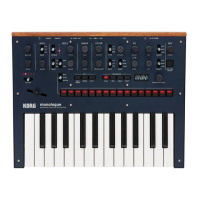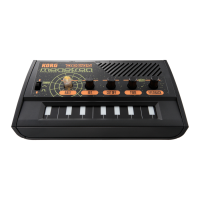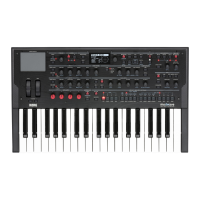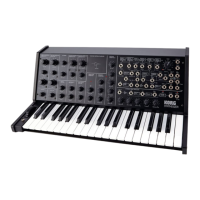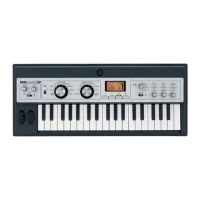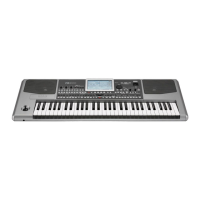1) HOLD
When this switch t% on. the
sound »
held tin any of the mod*).
2)
MONO
F<y using the Mono/poly as J man©
phonic synthesizer This uses a last now
priority system
?
CHORD
MEMORY
This
mode
allows
you to
"memorise"
an interval or chord
of uo to 14 notes)
and then produce Parallel harmonies
based on thai interval
or
chord with
monoohonic rone-finger") praying,
h
effectively eliminates
the need for manual
tuning of oscillators
to
form intervals or
chords, tor greater user convenience.
To enter an interval or chord into Chord
Memory
1. Se+ect
POLY
or UNISON/SHARE As-
i^nmocteti
2. Play
and hold the
desired chord.
3. Depress
CHORD
MEMORY
Note:
If Chord
is too
big
to
Way
with
one hand, depress
HOLD, play
the
indi
victual notes of the chord arm
at a lime,
and then depress
CHORD MEMORY
Alternately^ plug
a
nximeniary
*oot-
witch into the rear
panel Chord
Memory
Footswitch
jack,
play
the
chord
with
both hands,
and depress the foetswitch.
With CHORD
MEMORY on a sinflk
key deoreanon
transposes me memorized
chord of interval
so thai its
lowest
note ts
the same
as ihe note you just prayed.
Playing
a
new note will
reuonspopt the
chord
so
that
-u
lowest note again
co-
incides w>th the new note
played,
and
so
forth The lowest note of the chord will
always be the same
as
the last key
i
in effect, the synthesizer
be*
as if In the UNISON mode, except
thai
the
oscillators are automatically
tuned to memorized intervals instead of
to
the same
note. "Last Note Priority"
and "Return
to
Previous
Note" cap*
bt litres all
apply m
CHORD
MEMORY, as
with
UNISON
mode
The user may free'y
select
other
Key-
board Assign modes
(eg.
POLY.
UNISON/
SHARE. UNISON! without erasing the
memorized chord, which can
be
later
recalled
by
redepressirxj CHORD
MEM-
ORY (with ro
keys
depressed!.
A
memo-
rized chord will
be
erased if
CHORD
MEMORY rs depressed while
in the
POLY
(or UNISON/SHAREJ
mode* and
key*
are held
down. It
will
also be erased
when the synthesizer
is
turned off.
In
addition to
being played from
the
keyboard, a
memorized chord
may
also
be arpeggiated using
the
built-in Arpeg
g
attx After the desired chord rs memo-
rized,
switch on the Arpegg aior and play
the note pattern
you
wish to be
arpeg-
giatnj. The "memorized**
chord will
then
move
n
parallel
harmony, according
to
the notes in the arpeggiator pattern For
".i^M
1
!" '
tr
*r Tirftirin/o any r--_i|.
*
rr ,jj1
iewei(s gespieiten Note, abrufbere't auf
Anachtagen emer behebioen Taste
zjr
Verfugung
Durch Ernsaiz
des
CHORD MEMORY
zusammen mt
Synchro und Kreuz
modulation
lessen uch
sehr dynamrsche
Effekie erzielen Naheres
dazu
unier
Erweitene Anwendunovnooiichkeiien".
Des
effets vraimeni dynamiQues peuveni
etre obtenu*
en
assayam
d'utiloer
la
memoire
d
accord avec la synchronisation
at
la trensmodutation Se reporter au
paragraphe intitutf "Obtcntion d'un
resultat optimum
du
Mono/Poly" pour
avoir plus da Oi*Ta>
is.
M*mdfi« cftord ivmiu ru
Gnpetctwra
Akk<ydir*
ukrur
Accord ntTfimi
WM you pmv
Sretpflelen;
Ce «ii **i K»w*
a
«
^r
What
veu
b*m
IFm"
5-^iM
~
aa
"
'
*f
"
~*
12
Ce
qui onr^en
*
MptfNfeJ
Em
Ojespeicherier Akkord
bleibt
auch
bel
UrnKhaiten zwischen mono- und
polyphonem Einsaiz erhaiten. Loschung
erfolgi n«r durch Neuprogranvnierung
und
be*
Ausschalten
des
NetzschaJte*s
Bei Umschalten ven poiyphcnem Betneb
auf CHORD MEMORY Betneb *l aber
darauf zu achten. dais nicht zutillig
vor
dam Drucken
der
CHORD MEMORY*
Taste die Tastatur
betaugi
wird. dasonst
die
so
angeschtagenen Noten automatrscn
m den Speicher abernommen werden.
wodurch der oespeicnerieAkkord geioscht
wird
(eg.
C
E. Gl
usrng
CHORD
MEMORY,
then
activate the Arpeggiator and play a
C
Major ?th
|C. E+ G. 8.)
on the
keyboard. You wiJi h«ar
a C
Major
inad,
E Mator
triad.
G
Major triad and B Maior
triad in sequence, according to the pa;
tern and range selected.
Furthermore, this
seouence of chords can also be
memo-
rized
by
ihe Arpeggiator in its
"Latch"
mode (See ARPEGGIATOR
Sectk.nl,
and then advanced
using
a
footswitch
plugged into the
rear panel ARPEGGIO
TRIG IN >aok. or
other triggering device,
for spectacular effects!
Nova:
If the chord
to be
memorized ts
less than {A notes.) the remaining oscilla-
tors will
not
sound wnen m CHORD
MEMORY mode, thereby reduong the
instrument's overall
output. Use
Ithe
UNISON/SHARE
mode
or)
the
HOLD
mode
to "double up"
notes, for fattest
sounds
|see HOLD
mode)
Rt
L
'accord reste en memoire bien
qu*un changemrjnt oe mode soit open*,
tant gu'aucun autre accord n'est mis en
memoire
ou oue
ralimentation n'est
coupee.
Cepcndant. unc
transition
du mode poly
en mode oc memoire d'acccd. rw pas
oublier de rct-rcr les doigts du clavier
avant de preaaar
to
bouton de memoire
d'eccord
*inon
les notea oaii sont actueUe-
ment ouees
sereient
misent en
memoire
et
reccord precedent serait annul*
Note:
When SYNC or X MOO functions
are engaged via the "One Touch" Effects
section, playing poryphonic chords via
UNISON/SHARE, POLY and CHORD
MEMORY modes will not produce actual
chords *rom the oscillators, due
to
the
compfex oscillator
rnteractiorn
that these
effects
entail.
<ir tic*, the number of
actual
discernable
notes heard with the
Effects
section
engaged will
be etther
ont*
or two.
depending on the setting
of the
SINGLE/DOUBLt
switch
m
the
Effects
section.) However, playing polyphonic
chrxd*
will
change
the tonal quality oi
the
total
sound,
by
offsetting the oscil-
lators*
initial tuning.
As
an example,
tuning
ihe four VCOs in fifths using
CHORD
MEMORY and then
engage
SYNC m the
Single
mode will
cause
three
separate
notes to
sweep in
Sync
for each
key
depression.
ii
